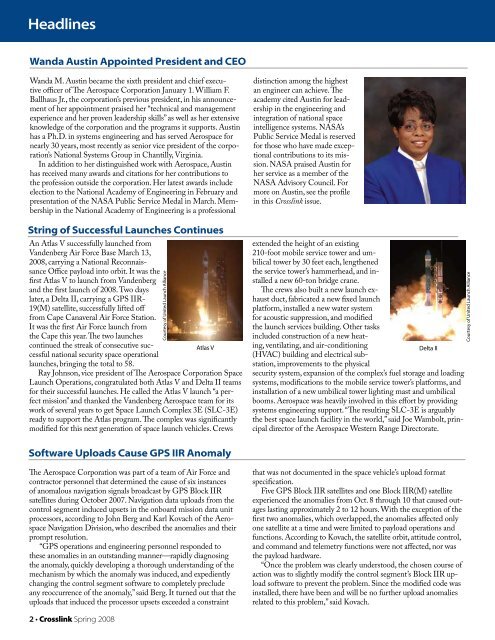Crosslink - Space-Library
Crosslink - Space-Library
Crosslink - Space-Library
Create successful ePaper yourself
Turn your PDF publications into a flip-book with our unique Google optimized e-Paper software.
Headlines<br />
Wanda Austin Appointed President and CEO<br />
Wanda M. Austin became the sixth president and chief executive<br />
officer of The Aerospace Corporation January 1. William F.<br />
Ballhaus Jr., the corporation’s previous president, in his announcement<br />
of her appointment praised her “technical and management<br />
experience and her proven leadership skills” as well as her extensive<br />
knowledge of the corporation and the programs it supports. Austin<br />
has a Ph.D. in systems engineering and has served Aerospace for<br />
nearly 30 years, most recently as senior vice president of the corporation’s<br />
National Systems Group in Chantilly, Virginia.<br />
In addition to her distinguished work with Aerospace, Austin<br />
has received many awards and citations for her contributions to<br />
the profession outside the corporation. Her latest awards include<br />
election to the National Academy of Engineering in February and<br />
presentation of the NASA Public Service Medal in March. Membership<br />
in the National Academy of Engineering is a professional<br />
String of Successful Launches Continues<br />
An Atlas V successfully launched from<br />
Vandenberg Air Force Base March 13,<br />
2008, carrying a National Reconnaissance<br />
Office payload into orbit. It was the<br />
first Atlas V to launch from Vandenberg<br />
and the first launch of 2008. Two days<br />
later, a Delta II, carrying a GPS IIR-<br />
19(M) satellite, successfully lifted off<br />
from Cape Canaveral Air Force Station.<br />
It was the first Air Force launch from<br />
the Cape this year. The two launches<br />
continued the streak of consecutive successful<br />
national security space operational<br />
launches, bringing the total to 58.<br />
Ray Johnson, vice president of The Aerospace Corporation <strong>Space</strong><br />
Launch Operations, congratulated both Atlas V and Delta II teams<br />
for their successful launches. He called the Atlas V launch “a perfect<br />
mission” and thanked the Vandenberg Aerospace team for its<br />
work of several years to get <strong>Space</strong> Launch Complex 3E (SLC-3E)<br />
ready to support the Atlas program. The complex was significantly<br />
modified for this next generation of space launch vehicles. Crews<br />
Courtesy of United Launch Alliance<br />
Atlas V<br />
distinction among the highest<br />
an engineer can achieve. The<br />
academy cited Austin for leadership<br />
in the engineering and<br />
integration of national space<br />
intelligence systems. NASA’s<br />
Public Service Medal is reserved<br />
for those who have made exceptional<br />
contributions to its mission.<br />
NASA praised Austin for<br />
her service as a member of the<br />
NASA Advisory Council. For<br />
more on Austin, see the profile<br />
in this <strong>Crosslink</strong> issue.<br />
extended the height of an existing<br />
210-foot mobile service tower and umbilical<br />
tower by 30 feet each, lengthened<br />
the service tower’s hammerhead, and installed<br />
a new 60-ton bridge crane.<br />
The crews also built a new launch exhaust<br />
duct, fabricated a new fixed launch<br />
platform, installed a new water system<br />
for acoustic suppression, and modified<br />
the launch services building. Other tasks<br />
included construction of a new heating,<br />
ventilating, and air-conditioning<br />
Delta II<br />
(HVAC) building and electrical substation,<br />
improvements to the physical<br />
security system, expansion of the complex’s fuel storage and loading<br />
systems, modifications to the mobile service tower’s platforms, and<br />
installation of a new umbilical tower lighting mast and umbilical<br />
booms. Aerospace was heavily involved in this effort by providing<br />
systems engineering support. “The resulting SLC-3E is arguably<br />
the best space launch facility in the world,” said Joe Wambolt, principal<br />
director of the Aerospace Western Range Directorate.<br />
Courtesy of United Launch Alliance<br />
Software Uploads Cause GPS IIR Anomaly<br />
The Aerospace Corporation was part of a team of Air Force and<br />
contractor personnel that determined the cause of six instances<br />
of anomalous navigation signals broadcast by GPS Block IIR<br />
satellites during October 2007. Navigation data uploads from the<br />
control segment induced upsets in the onboard mission data unit<br />
processors, according to John Berg and Karl Kovach of the Aerospace<br />
Navigation Division, who described the anomalies and their<br />
prompt resolution.<br />
“GPS operations and engineering personnel responded to<br />
these anomalies in an outstanding manner—rapidly diagnosing<br />
the anomaly, quickly developing a thorough understanding of the<br />
mechanism by which the anomaly was induced, and expediently<br />
changing the control segment software to completely preclude<br />
any reoccurrence of the anomaly,” said Berg. It turned out that the<br />
uploads that induced the processor upsets exceeded a constraint<br />
that was not documented in the space vehicle’s upload format<br />
specification.<br />
Five GPS Block IIR satellites and one Block IIR(M) satellite<br />
experienced the anomalies from Oct. 8 through 10 that caused outages<br />
lasting approximately 2 to 12 hours. With the exception of the<br />
first two anomalies, which overlapped, the anomalies affected only<br />
one satellite at a time and were limited to payload operations and<br />
functions. According to Kovach, the satellite orbit, attitude control,<br />
and command and telemetry functions were not affected, nor was<br />
the payload hardware.<br />
“Once the problem was clearly understood, the chosen course of<br />
action was to slightly modify the control segment’s Block IIR upload<br />
software to prevent the problem. Since the modified code was<br />
installed, there have been and will be no further upload anomalies<br />
related to this problem,” said Kovach.<br />
2 • <strong>Crosslink</strong> Spring 2008
















